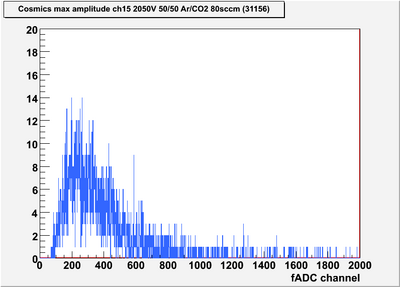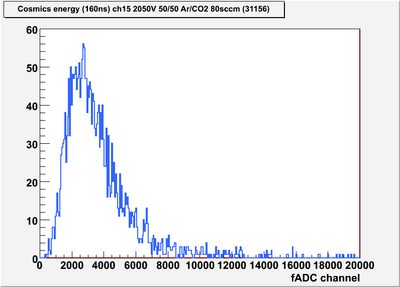55Fe vs cosmics
From Sauli's Principles of operation of multiwire proportional and drift chambers,
energy loss at atmospheric pressure for minimum ionizing particles is 2.44 keV/cm in Ar and 3.01 keV/cm in CO2 so for a 50/50 mix, and the shortest path through the centre of one straw (1.6 cm), cosmics should deposit a total of 4.4keV at a rate of 2.7 keV/cm.
The 55Fe source produces 6.0keV xrays. (55Fe decays by electron capture to 55Mn which de-excites by x-ray emission; Kα at 5.9 keV or Kβ X-ray at 6.5 keV with relative intensity 150:42 (Kaye&Laby 1973(!)) so the intensity-weighted average is (5.90*100+5.89*50+6.49*42)/192= 6.0 keV.)
The x-rays undergo photoelectric absorption by Ar; Ar emits a photoelectron and then de-excites either by Auger emission (87%) or fluorescence (13%); fluorescence produces the Ar escape peak at 3.0keV when the initial photoelectron causes an avalanche but the 3keV photon does not.
3keV electrons have a range of ~ 100 um in Ar (Sauli) which at a uniform rate of deposition (bad approximation to give a rough idea) is 300 keV/cm and 100 x greater than that for cosmics. So although the total energy deposited is similar for at 6keV for 55Fe and 4.4keV for cosmics, the rate of deposition is very different.
Histograms for 55Fe at 2050V
Cosmics, amplitude integrated over 160ns
Cosmics, amplitude integrated over 750ns (max drift time)




